Understanding the Roots and Consequences of Emotional Avoidance in Romantic Relationships
Emotional avoidance is a prevalent yet complex behavior that significantly impacts romantic relationships. Rooted in childhood experiences and attachment styles, it often acts as a self-protective mechanism, but paradoxically, it can lead to relationship sabotage. This article explores the intricate link between emotional avoidance and destructive relationship patterns, examining underlying psychological mechanisms, attachment dynamics, and trauma responses, along with strategies for healing and fostering healthier connections.
The Foundations of Emotional Avoidance: Childhood Trauma and Attachment Styles
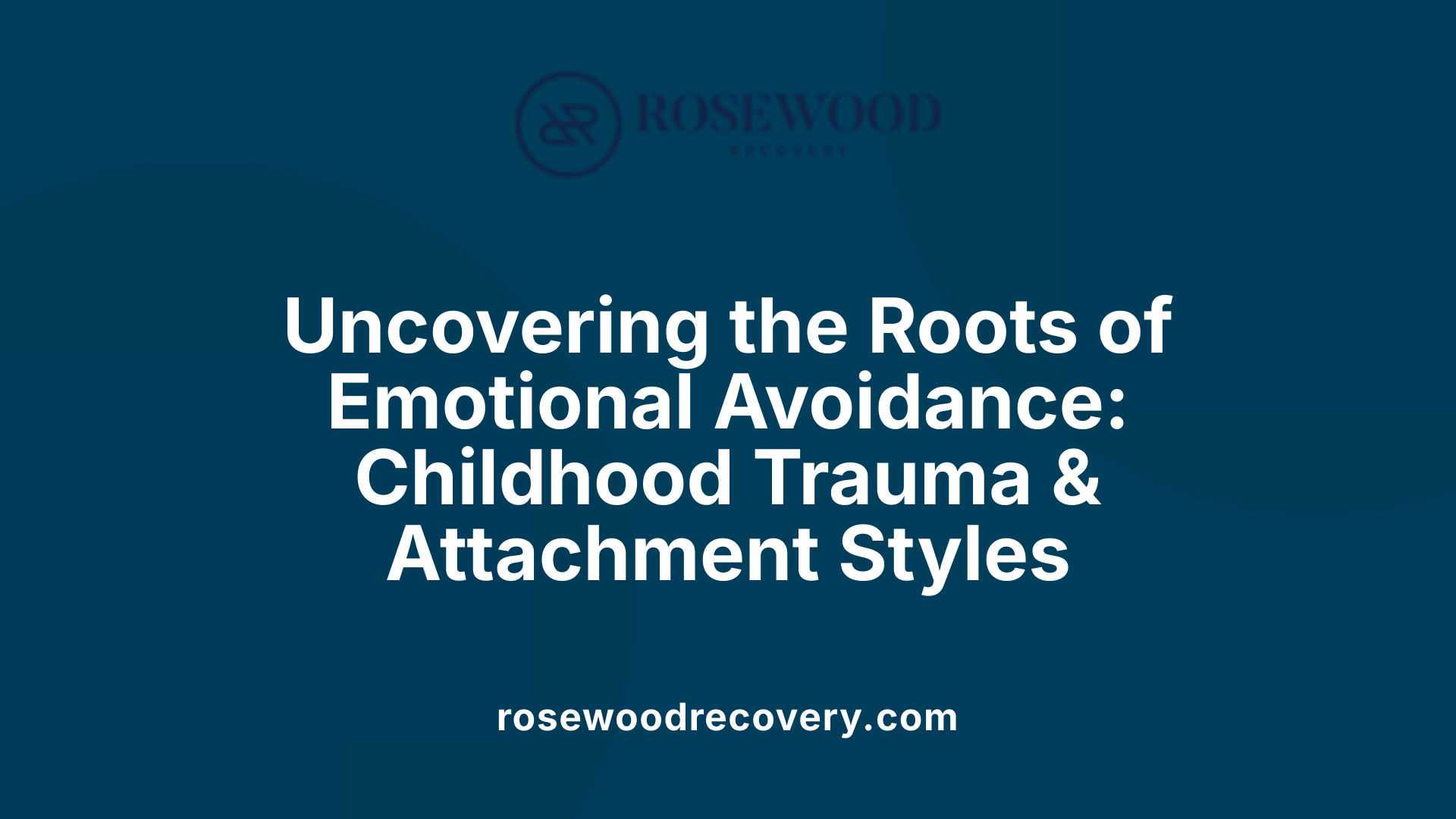 Childhood experiences play a critical role in shaping how individuals emotionally connect or distance themselves in adult relationships. Early neglect, emotional rejection, or inconsistency from caregivers can foster feelings of unworthiness and foster defenses that block emotional intimacy later in life.
Childhood experiences play a critical role in shaping how individuals emotionally connect or distance themselves in adult relationships. Early neglect, emotional rejection, or inconsistency from caregivers can foster feelings of unworthiness and foster defenses that block emotional intimacy later in life.
Attachment theory offers a framework to understand these behaviors. Developed by psychologist John Bowlby, it explains how early interactions with caregivers influence relationship patterns. When attachment needs are unmet or poorly responded to, children may develop insecure styles, such as avoidant attachment, characterized by emotional distancing and difficulty trusting others.
Individuals with an avoidant attachment style often learned to suppress their feelings as a survival strategy. This stems from early rejection or dismissiveness from caregivers, which taught them that relying on others could lead to rejection or vulnerability. As adults, this manifests as reluctance to open up, avoidance of emotional closeness, and a preference for independence.
Trauma responses further deepen emotional avoidance. Childhood trauma—be it emotional neglect, abuse, or traumatic loss—can reinforce beliefs that emotional pain is dangerous. These individuals may internalize that emotional vulnerability results in harm, leading to behaviors aimed at self-protection, like emotional shutdown or withdrawing from intimacy.
Neurobiological factors also contribute. Brain regions involved in emotional regulation, such as the amygdala and prefrontal cortex, may be impacted by trauma or mental health conditions like anxiety and depression. These changes can impair emotional awareness and response, making avoidance a default mode.
In sum, emotional avoidance is rooted in complex interaction among childhood experiences, attachment patterns, trauma responses, and neurobiological factors. Understanding these origins helps explain why some individuals struggle with trust, vulnerability, and intimacy, and highlights the importance of addressing these issues through therapy and personal development.
The Role of Emotional Patterns in Self-Sabotage and Relationship Dynamics
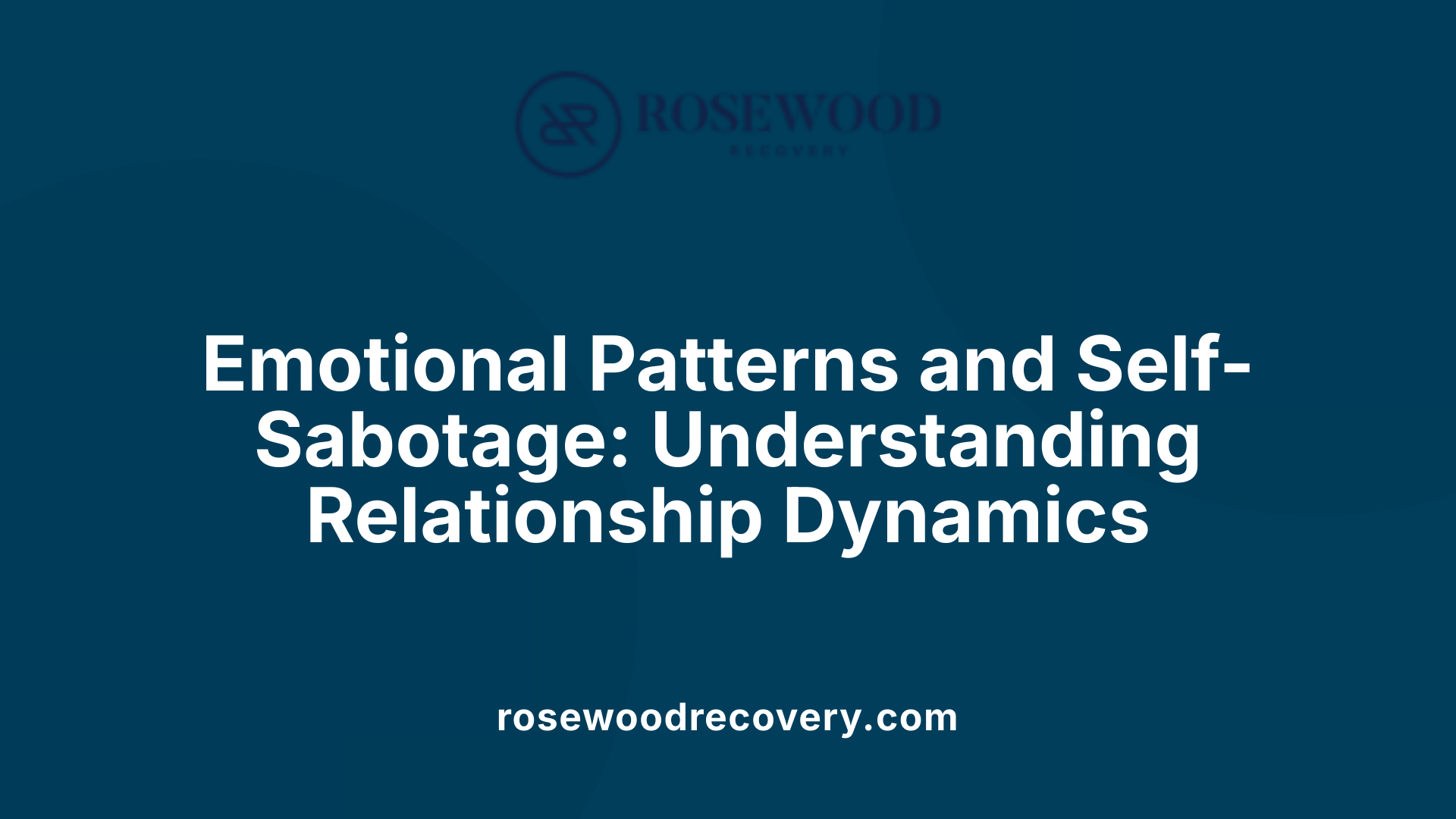
How do emotional patterns contribute to self-sabotage within relationships?
Emotional patterns play a significant role in shaping how individuals behave in romantic relationships, particularly in ways that lead to self-sabotage. Common patterns include the fear of abandonment, mistrust, low self-esteem, and emotional avoidance. When these feelings are unresolved, they can cause people to withdraw, criticize, or provoke conflicts with their partners.
Unmet childhood needs, such as experiences of neglect, betrayal, or emotional abuse, often create core beliefs of unworthiness or fears of rejection. These negative beliefs foster insecurities and reactively trigger defensive behaviors, like distancing oneself or sabotaging intimacy, as a form of self-protection.
Attachment insecurities also reinforce these patterns. For example, individuals with anxious attachment may cling or excessively seek reassurance, while avoidant types may shut down emotionally or push others away. These responses lead to a cycle of mistrust and conflict, making it difficult to establish and sustain healthy relationships.
Moreover, unresolved trauma from the past compounds these emotional reactions. Trauma responses—like hypervigilance or emotional shutdown—become ingrained, often operating unconsciously. As a result, even minor issues can escalate or trigger destructive behaviors, spiraling into self-sabotage.
What signs indicate self-sabotaging relationships?
Identifying self-sabotage can be crucial in addressing relationship issues. Common signs include:
- Gaslighting or denying valid feelings and experiences
- Constant criticism or finding faults in a partner
- Avoiding difficult conversations or intimacy
- Recurrent breakups over seemingly minor conflicts
- Jealousy or possessiveness
- Emotional unavailability or shutting down emotionally
- Low self-esteem, leading to doubts about worthiness
- Behaviors like seeking exits or creating conflict to preempt abandonment
These behaviors often occur without conscious intent, rooted in deep-seated fears and past trauma. Recognizing these signs can lead to seeking help through therapy or self-awareness practices, which are pivotal for breaking the cycle of self-sabotage.
Psychological Mechanisms and Trauma Responses Underpinning Sabotage
What psychological mechanisms and trauma responses are involved in emotional avoidance and sabotage?
Unresolved childhood trauma, such as emotional neglect, abuse, or dysfunctional family environments, profoundly shapes adult relationship behaviors. These early experiences instill core beliefs about safety, trust, and self-worth that influence how individuals engage with their partners later in life.
Trauma responses like fear of abandonment, feelings of low self-esteem, and challenges with intimacy serve as protective mechanisms. They prompt behaviors such as emotional shutdown—muting feelings or withdrawing from emotional closeness—and controlling or defensive actions to shield oneself from perceived threats.
These automatic reactions foster mistrust and reluctance to be vulnerable, which can be misinterpreted as relationship sabotage. Over time, this cycle reinforces emotional avoidance, making it difficult for individuals to maintain stable, trusting partnerships.
How do trauma responses like fear of abandonment and low self-esteem contribute?
Fear of abandonment often originates from early attachment wounds, leading individuals to preemptively distance themselves to avoid the pain of rejection or betrayal. Similarly, low self-esteem drives internal narratives of unworthiness, fueling distrust and suspicion.
These responses trigger behaviors such as emotional withdrawal, excessive neediness, or pushing partners away. Consequently, they create a self-fulfilling cycle where fear and mistrust lead to behaviors that undermine relationship stability, perpetuating emotional disconnection and sabotage.
Understanding that these responses are rooted in past trauma highlights the importance of therapeutic work to address underlying wounds, fostering healthier attachment styles, and reducing self-protective avoidance behaviors.
The Interplay of Traumatic Childhood Experiences and Adult Relationship Patterns
How do early abandonment, neglect, and emotional abuse shape adult relationship behaviors?
Experiences of childhood trauma such as abandonment, neglect, or emotional abuse can leave lasting scars that influence how individuals form and maintain relationships in adulthood. These adverse experiences often lead to deep-seated fears of betrayal or rejection, which manifest as emotional avoidance or self-defeating behaviors.
Children who face neglect or emotional abuse may internalize a negative self-image and develop mistrust toward others. This mistrust extends into adult relationships, making it difficult to feel safe and secure with a partner. As a result, many struggle with commitment, often engaging in self-sabotage, withdrawing during conflicts, or testing their partner's loyalty.
Unresolved trauma triggers internal conflicts in adult partners, such as fears of abandonment or engulfment. These fears can prompt push-and-pull dynamics, where individuals oscillate between craving closeness and pushing others away. Such patterns not only impede emotional intimacy but also reinforce negative beliefs about oneself and relationships.
Understanding how early trauma influences adult relationship behaviors is crucial for addressing patterns of insecurity, emotional avoidance, and relationship sabotage. Therapies aimed at healing childhood wounds can help individuals develop healthier attachment styles and build more fulfilling relationships.
What are the root causes of emotional avoidance like fear of vulnerability and trust issues?
Rooted in early childhood experiences, emotional avoidance often develops from neglect, rejection, or emotional abuse. These traumatic events lead children to associate vulnerability with potential pain, shame, or punishment. Over time, these sensations become embedded, fostering fears of being betrayed, abandoned, or overwhelmed by intimacy.
Such adverse experiences impair the development of trust, making it challenging for adults to fully open up or rely on others. They may unconsciously adopt deactivation strategies, like withdrawal or emotional shutdown, to protect themselves from perceived threats.
Attachment insecurities formed during childhood, such as avoidant or dismissive styles, persist into adulthood, influencing relationship behaviors. These individuals often prefer independence over closeness and may dismiss their partner’s needs to avoid feeling vulnerable.
Addressing these root causes through therapy or self-awareness practices is essential for overcoming emotional avoidance. Developing a secure inner foundation can enable healthier relationship dynamics, fostering trust and emotional connection.
How do childhood trauma and attachment styles relate to self-sabotage?
Childhood trauma significantly impacts attachment styles, which in turn influence adult relationship behaviors. For example, insecure attachment patterns—such as anxious or avoidant styles—tend to predispose individuals to self-sabotage.
Anxiously attached individuals often worry excessively about losing their partner, leading to clingy, jealous behaviors or over-communication, which can push partners away. Conversely, avoidant types may engage in deactivation strategies, distancing themselves emotionally or avoiding commitment altogether.
These patterns serve as protective mechanisms rooted in early trauma. They stem from a desire to prevent the pain associated with rejection, betrayal, or engulfment experienced during childhood.
By understanding their attachment history, individuals can recognize self-sabotaging tendencies, work through underlying fears, and develop healthier ways of relating. Therapy, especially attachment-based approaches, can facilitate this transformation by addressing core wounds and fostering emotional resilience.
How Relationship Sabotage Manifests: Defensiveness, Mistrust, and Skill Deficits
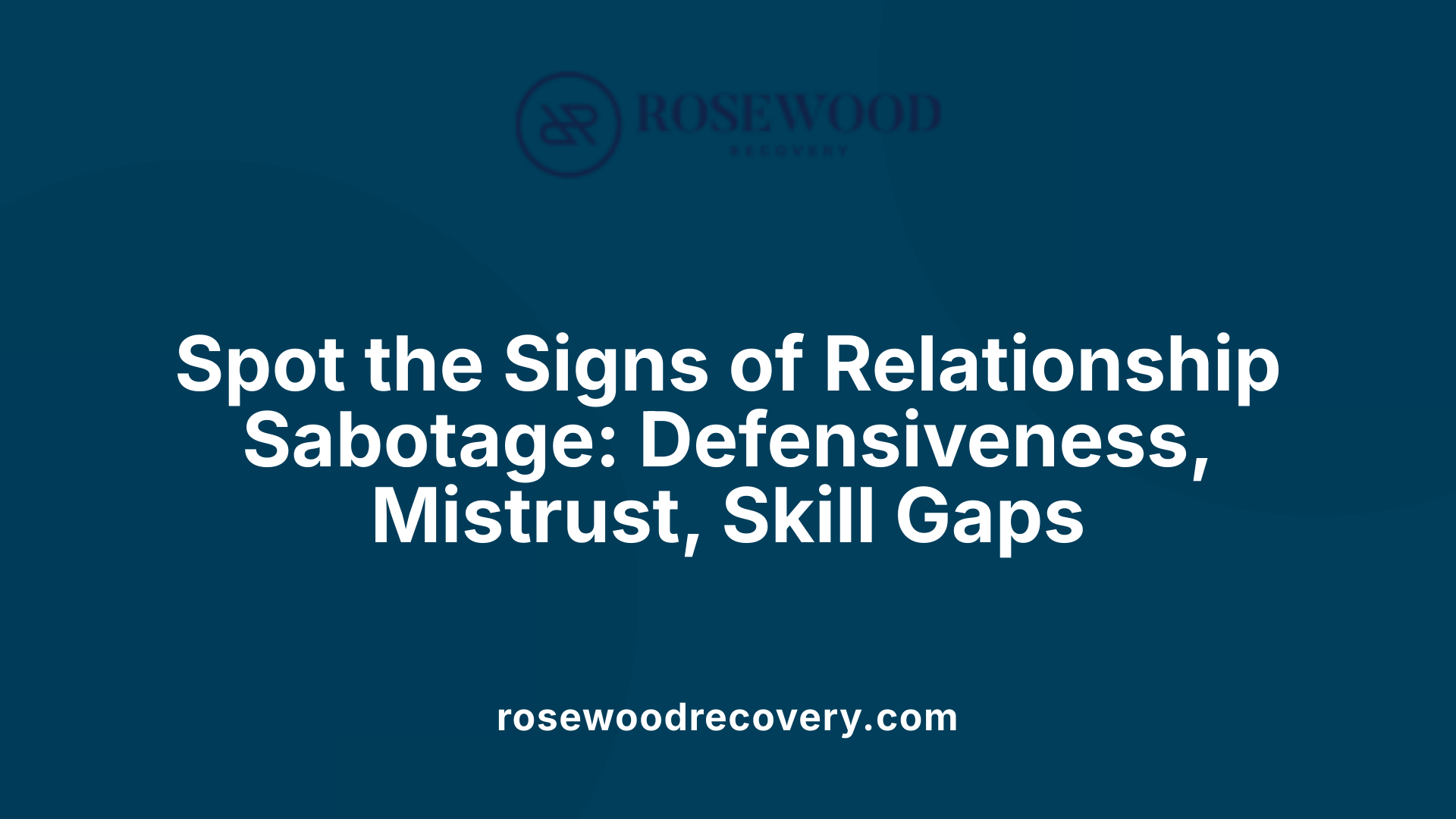
What is the Relationship Sabotage Scale?
The Relationship Sabotage Scale (RSS) is a tool developed from attachment theory and goal-oriented relationship models. It consists of 12 items that assess how individuals may undermine their romantic relationships through behaviors and attitudes.
The scale measures three main factors:
- Defensiveness
- Trust difficulty
- Lack of relationship skills
These factors highlight common ways people can unintentionally hinder connection and intimacy.
What are the signs of self-sabotaging relationships?
Self-sabotage manifests in various ways. Common signs include:
- Gaslighting and constant criticism of partners
- Avoiding difficult conversations or conflict
- Engaging in frequent breakups over minor issues
- Excessive jealousy and emotional unavailability
- Low self-esteem and feelings of unworthiness
- Seeking exits or creating drama to preempt perceived rejection
From trauma and unresolved childhood wounds, these behaviors often operate unconsciously. Recognizing these patterns is a vital first step toward healthier relationship dynamics and can be addressed effectively through therapy and increased self-awareness.
Why do individuals sabotage their relationships?
Many factors contribute to relationship sabotage, most notably deep-seated fears of vulnerability, abandonment, or losing independence. These fears are frequently rooted in childhood trauma, insecure attachment styles, or past relationship experiences.
Sabotaging behaviors serve as defenses, preemptively protecting individuals from emotional pain by creating distance or chaos in the relationship. While often subconscious, understanding these motivations can help individuals work towards more secure attachment and healthier relational habits.
How does attachment style influence relationship sabotage?
Attachment styles significantly impact how individuals behave in romantic relationships and whether they engage in self-sabotaging actions. For example:
| Attachment Style | Common Sabotage Behaviors | Root Causes |
|---|---|---|
| Avoidant | Withdrawing, deactivation, nitpicking, flirting outside the relationship | Childhood rejection of emotional needs, desire for independence |
| Anxious | Clinginess, constant reassurance seeking, jealousy | Fear of abandonment, emotional hyper-sensitivity |
| Fearful-Avoidant | Erratic withdrawal and approach, internal conflict | Combined fears of abandonment and engulfment |
Attention to these attachment patterns can guide therapeutic interventions aimed at fostering healthier, more secure relationship behaviors.
How can therapy help address self-sabotage?
Therapeutic approaches focus on increasing awareness of underlying fears and trauma, understanding attachment patterns, and developing healthier skills. Techniques include emotion regulation, challenging negative beliefs, and practicing vulnerability.
By working through childhood wounds and trauma, individuals gain better control over self-sabotaging impulses, leading to more stable and fulfilling relationships.
What is emotional self-sabotage and how does childhood trauma contribute?
Emotional self-sabotage often begins in childhood, especially when early experiences involve neglect, abuse, or invalidation. Children learn to associate feeling good with danger, leading to internal conflicts where positive feelings are suppressed.
As adults, this can result in behaviors like shutting down positive emotions or doubting oneself, corresponding to the traumatic messages received early on.
How do attachment and trauma influence post-conflict behaviors?
Post-conflict, some individuals engage in what is called recovery sabotage, where they revisit previous conflicts, bring up new issues, or negate positive contributions. This is often linked to high attachment anxiety, where the fear of abandonment causes persistent negativity.
Research shows such behaviors can predict long-term relationship dissatisfaction. Addressing attachment fears and unresolved trauma reduces recovery sabotage and promotes healthier conflict resolution.
In summary, understanding the intertwined roles of attachment, childhood trauma, and self-sabotaging behaviors provides valuable insight into how relationships can be consciously nurtured and protected against destructive patterns.
The Impact of Emotional Avoidance on Relationship Stability and Conflict
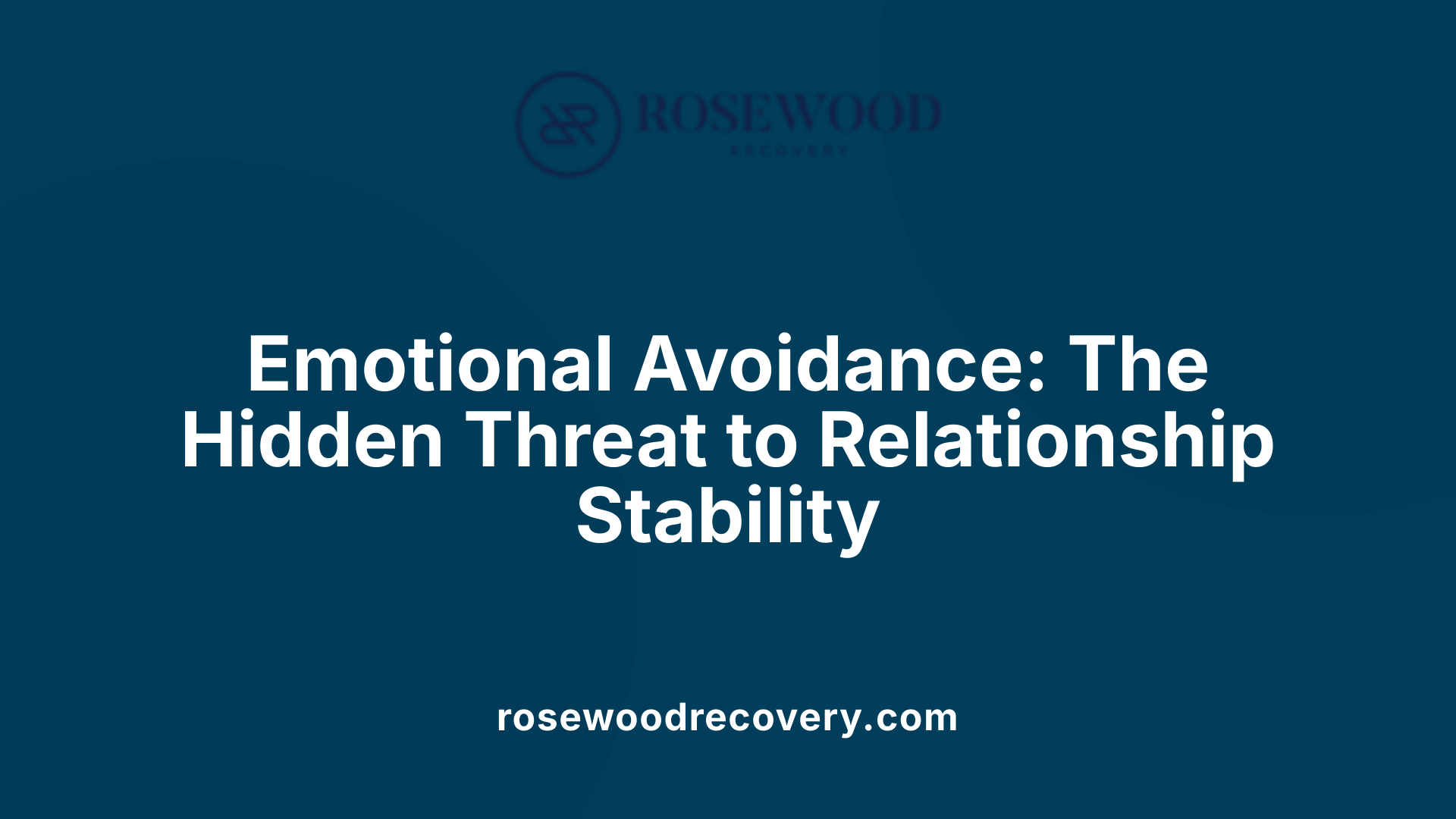
How does emotional avoidance affect relationship stability and conflict?
Emotional avoidance significantly undermines the foundation of a healthy relationship. When individuals suppress their feelings or avoid discussing difficult topics, it creates a barrier to authentic connection. This disconnect hampers mutual understanding, leading to misunderstandings and increased conflict.
Suppressed emotions tend to build up, causing internal tension and irritability. Over time, this internal pressure diminishes the ability to resolve conflicts constructively. The emotional disconnect reduces trust and intimacy, often leading to feelings of loneliness within the relationship.
Furthermore, avoidance can prevent partners from addressing issues early on, allowing problems to escalate unnoticed. The lack of emotional openness also impairs conflict resolution, making disagreements more intense and less productive. This cycle of avoidance and misunderstanding can threaten the longevity of the relationship.
In what ways does avoidance influence destructive behaviors?
Avoidance fuels patterns that are destructive to relationship health. When individuals choose to disengage rather than confront issues, miscommunication often occurs. This can lead to frustration and misunderstanding, as one or both partners may feel ignored or invalidated.
Defensive reactions such as criticism, withdrawal, or emotional disengagement often follow avoidance. These behaviors can escalate conflicts, foster resentment, and deepen emotional rifts. As avoidance persists, it perpetuates a cycle of emotional distancing that weakens the bond between partners.
In the long run, these destructive behaviors—such as serial withdrawal or passive-aggressive actions—can cause relationships to break down entirely. Recognizing and addressing emotional avoidance is crucial for building resilience, fostering open communication, and maintaining relationship stability.
Strategies for Healing: Addressing Emotional Avoidance and Prevention of Sabotage
How can individuals address emotional avoidance?
Emotional avoidance often stems from past trauma or insecure attachment styles. To address this, individuals should focus on increasing self-awareness—identifying personal triggers and recognizing patterns of emotional shutdown or withdrawal.
Engaging in therapy is a powerful step, as it provides a safe space to explore unresolved childhood wounds, trauma, or dysfunctional family dynamics that contribute to avoidance behaviors. Techniques like emotional regulation exercises, journaling, and mindfulness can help manage the anxiety associated with vulnerability.
Developing healthy communication skills is also crucial. This includes learning to express needs and emotions openly without fear of judgment or rejection. Additionally, working on attachment issues with a mental health professional can help build trust, foster vulnerability, and promote greater intimacy.
Building these skills over time supports healthier relational patterns and decreases the likelihood of sabotage driven by emotional avoidance.
Conclusion: Moving Towards Secure Attachments and Fulfilling Relationships
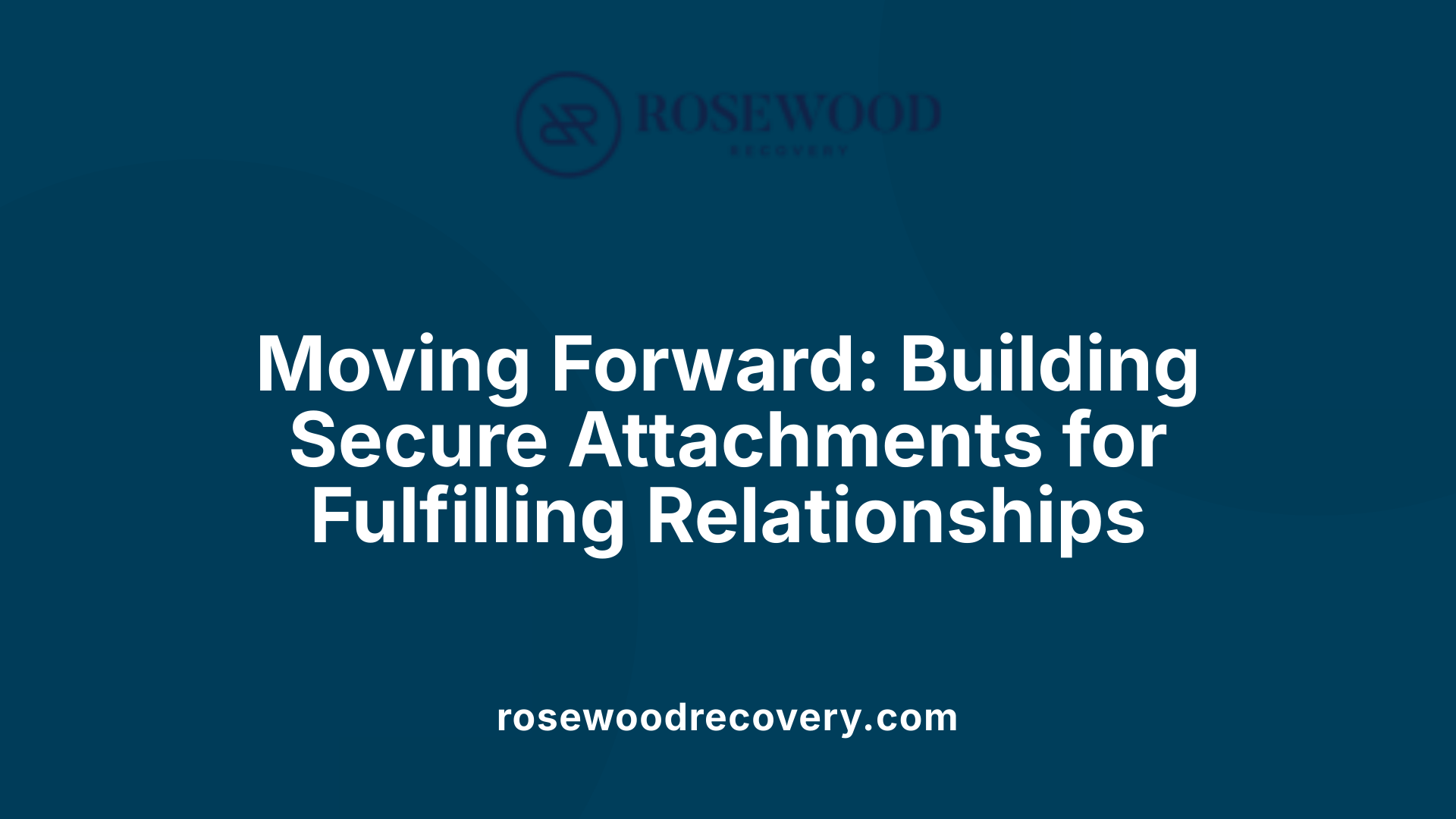 Building secure attachment styles is fundamental to fostering healthy and fulfilling romantic relationships. Self-awareness plays a crucial role in recognizing and understanding personal patterns of behavior, particularly those rooted in trauma or childhood experiences. By exploring underlying fears such as abandonment, mistrust, or dependency, individuals can begin to address the root causes of self-sabotage.
Building secure attachment styles is fundamental to fostering healthy and fulfilling romantic relationships. Self-awareness plays a crucial role in recognizing and understanding personal patterns of behavior, particularly those rooted in trauma or childhood experiences. By exploring underlying fears such as abandonment, mistrust, or dependency, individuals can begin to address the root causes of self-sabotage.
Trauma healing is an essential step in this process. Therapeutic interventions, such as counseling or therapy, can help individuals unpack past wounds, learn healthier coping mechanisms, and reduce emotional barriers impeding intimacy. Such work fosters emotional resilience and promotes a more secure sense of self.
Developing healthy attachment involves cultivating trust, openness, and consistent communication with partners. This can be achieved by practicing self-compassion, setting healthy boundaries, and engaging in ongoing personal growth. As individuals stabilize their emotional foundations, they create the conditions necessary for secure, supportive partnerships.
Focusing on these areas—self-awareness, trauma recovery, and attachment security—supports long-term relationship satisfaction. Emphasizing personal development and emotional regulation ultimately helps break cycles of self-sabotage, leading towards more connected and resilient partnerships.
Fostering Emotional Security for Lasting Love
Understanding the profound connection between emotional avoidance and relationship sabotage illuminates pathways for healing. Recognizing how childhood wounds, attachment insecurities, and trauma responses fuel destructive patterns enables individuals to work towards emotional openness and secure attachment. With awareness, therapeutic support, and intentional effort, it is possible to break free from cycles of self-protection that hinder true intimacy. Cultivating emotional security paves the way for resilient, trusting, and fulfilling relationships, ultimately transforming destructive cycles into avenues for growth and connection.
References
- The relationship sabotage scale: an evaluation of factor analyses ...
- I Found Out How Avoidants Sabotage Relationships (It's Wild)
- How Some People Sabotage Their Own Relationships
- Self-Sabotaging Relationships: Signs & Causes - Talkspace
- Are You Self-Sabotaging Your Relationship? - Verywell Mind
- Emotional Self-Sabotage - Psychology Today
- The Dyadic Construction of Romantic Conflict Recovery Sabotage
- Anxious Attachment: Self-Sabotaging Romance — Seattle Psychiatrist

.jpeg)


